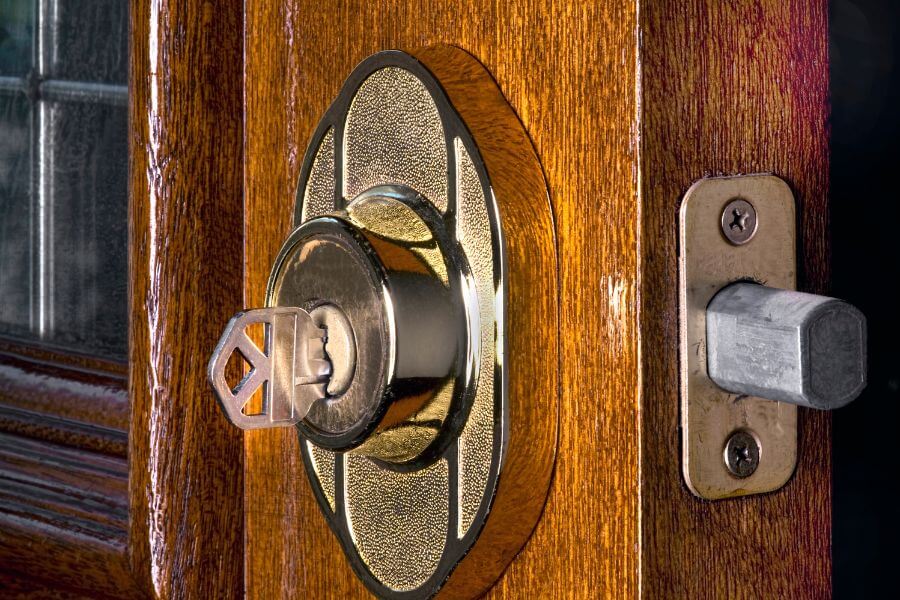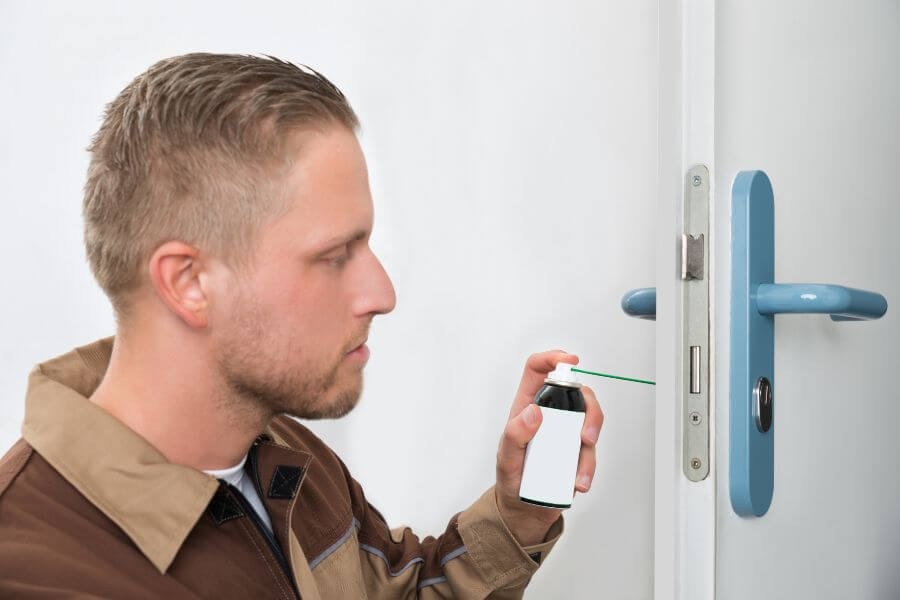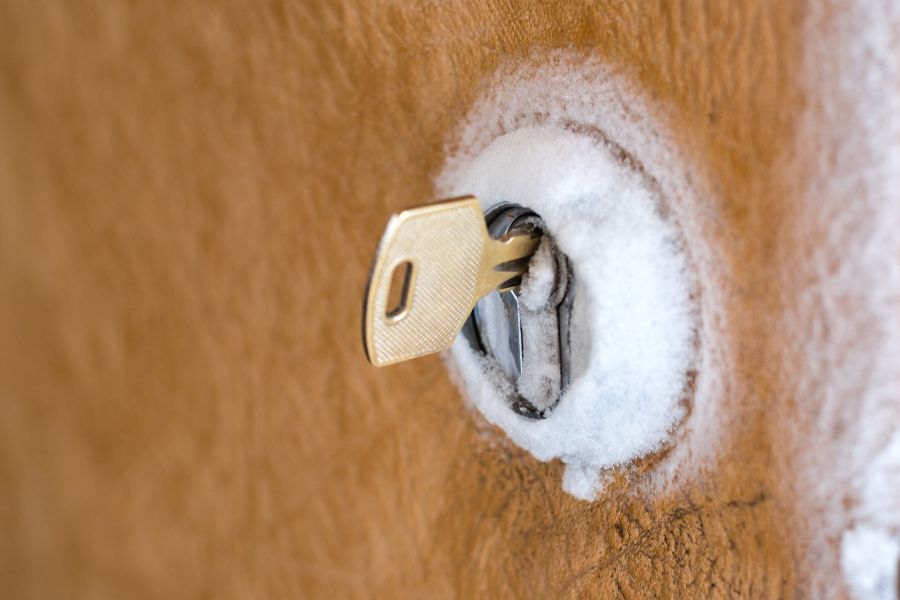Deadbolt locks are one of the most sturdy ones you can rely on, keeping your home safe and secure. They have special bolts that won’t allow any forcible entry.
These locks also require keys or thumb turns before they can be opened. Besides, they are not spring-activated, so you cannot open them using credit cards. But like other locks, deadbolts may malfunction.
To fix a deadbolt that won’t turn, spray a dry lubricant on the keyway, then insert the key to unlock the door. You can insert the key into the lock, twist it back and forth, and tap it with a hammer. Warm up the key for a frozen lock, then insert it. Other ways are aligning the door and removing the lock for inspection.
Why Won’t My Deadbolt Turn?

Figuring out why the deadbolt won’t turn is vital so you will know how to fix it. The reason why the deadbolt won’t turn may be rooted in a manufacturing issue or poor installation.
Other causes are damaged deadbolts or misaligned doors. You must also check if the metal keeper plate is jammed.
Manufacturing Issue
A manufacturing issue may occasionally happen to deadbolt locks. Before buying a deadbolt lock, you must try it first to check if it is working correctly.
If you plan to buy online, check the customers’ reviews before checking out your order. Once you get the deadbolt lock, you must take a video of the unboxing, so you’ll have evidence that it doesn’t work.
The best way to solve a manufacturing issue is to contact the lock manufacturer. You can check their contact information through their websites. Some lock manufacturers will replace the malfunctioning lock with a new one.
Poorly Installed Lock
Installation of the lock affects its overall performance. Some homeowners who fail to install their locks properly become victims of burglary. If the deadbolt lock cannot be turned fully, it is easier for the robber to push it back in.
The mortises must fit together perfectly. If the mortises are not perfectly cut, the moving parts of the deadbolt lock may rub against the wood. For this reason, the deadbolt lock cannot be turned fully.
Damaged Deadbolt
One of the reasons why your deadbolt cannot be turned is that it is already damaged. Although deadbolt locks are sturdy, they are still prone to wear and tear.
Depending on the condition of the lock, it may need repair or replacement.
Bent tailpieces may prevent you from turning the deadbolt fully. A tailpiece is located on the rim locks, extending on the back of the lock.
You can still repair a bent tailpiece since you don’t have to disassemble the lock to remove it. However, issues like damaged pins require replacement.
Misaligned Doors
Misaligned doors may also affect the efficiency of the deadbolt locks. Causes of a misaligned door include loose screws on the door’s hinges or increasing house age.
It may also misalign if you improperly put the door after taking it off for repaint. If there is misalignment, the door scrapes along the floor or gets stuck whenever you move it.
You can ask someone to repair the door or do it yourself. Prevent the door from misaligning by inspecting the hinges and avoiding slamming it.
Jammed Metal Keeper Plate
A jammed metal keeper can prevent the deadbolt lock from turning. The metal keeper plate must align perfectly with the door jamb.
If the lock keeps on jamming, you can enlarge the hole in the metal plate. Thus, it would be easier for the latch to slide into the hole. You can also reposition the metal keeper plate if this does not solve the problem.
What Can I Do If Deadbolt Won’t Turn?

The security of your home depends on the efficiency of your deadbolt lock. Ignoring its issue may result in bigger problems.
Before you get disappointed, there are a couple of things that you can do if your deadbolt won’t turn.
Call a Professional Locksmith
If you don’t know how a deadbolt works, you can call a professional locksmith to help you. It is also the best solution if it is an emergency and you don’t have the time to figure out how to fix the deadbolt. However, you must ensure that the locksmith is licensed.
Researching the company’s whereabouts is crucial when calling a locksmith. You should not miss checking its online reviews and ratings. The company should be able to provide you with its business name and license. You must also ask for a quote before hiring the locksmith.
Once the locksmith arrives, he will ask you for your identification to verify that the house is yours. You must also see him come in a signed vehicle and uniform.
A professional locksmith would not also drill the lock without conducting an inspection. It is the last option since they can quickly fix malfunctioning door locks.
Do-It-Yourself-Solutions
If you are up to the challenge, there are also do-it-yourself solutions to turn your deadbolt. It is an ideal solution for those who want to save money.
But ensure you have the proper tools and follow the correct procedures. Instead of fixing the lock, its condition may worsen, costing you a lot more.
Those with a background in deadbolt locks can also resort to DIY solutions. As long as you know what the parts are and how they function, it is easy to fix them.
The following section will tackle DIY steps to help fix a deadbolt that won’t turn.
5 DIY Steps To Do To Fix a Deadbolt That Won’t Turn
There are different DIY options to fix a deadbolt that won’t turn. Choose the one that will suit you and your situation.
As we mentioned before, you must have the proper tools. Pick the step where you already have the available tools to save time and money.
1. Lubricate the Lock

One of the easiest DIY solutions is lubricating the lock. The moving parts of the lock may not function well because of rust, grime, and dirt build-up. Dry graphite lubricant is the best option. It prevents any build-up and is an excellent lubricant in high and low temperatures.
One of the best options is dry graphite lubricant
If you don’t have a dry graphite lubricant, you can use WD-40. It is a penetrating oil that can lubricate moving parts and loosens rusted bolts. However, this lubricant is temporary since it may clog the lock over time. Remember, never use oil since it may compound the dirt inside the lock.
To begin, remove the dirt inside the lock using an air compressor or a can of pressurized air. The next step is to apply the lubricant inside the lock’s hole.
Insert the key inside the keyhole and move it back and forth to spread the lubricant. Turn the key and open the door. If this procedure doesn’t work, you can perform other DIY solutions.
2. Tapping the Lock With a Hammer
Tapping the lock with a hammer is a quick solution. But there is a chance that the lock may be damaged permanently if not done correctly. The best hammer to use is a bump hammer. This hammer can exert the proper force without damaging the deadbolt lock.
In doing the procedure, insert the key inside the keyhole. Once done, apply a turning pressure on the lock. Tap the lock or the key with a hammer. The pins inside the lock will move randomly, turning the deadbolt.
3. Use a Warm Key If The Lock Is Frozen

Extreme cold weather may result in a frozen deadbolt, preventing you from turning it. The only solution is to warm the key using a lighter or a hot liquid.
You can warm the key with a lighter, but be careful since you may hurt yourself. Once the key is hot enough, insert it into the keyhole, then turn it slowly, unlocking the deadbolt.
If you prefer hot water, place the key on it until it is warm enough. Dry the key before inserting it inside the lock since it may freeze immediately.
After wiping it, place it into the keyhole and turn it.
4. Align the Door
Since a misaligned door may also cause a deadbolt won’t turn, you have to align it. There are different ways to fix a misaligned door, depending on the problem.
If the top of the door is sagging on the door frame, you need to tighten the hinge screws.
If this doesn’t solve the problem, try to tighten the latch side of the door jamb. To do this, you have to determine the points where to place the screws.
Mark it with a pencil and create a pilot hole using a drill. Using a fluted countersink bit, drive the screw into the hole. You may also want to tighten the strike plate using a screwdriver.
5. Remove And Inspect the Deadbolt
Your last option is to remove and inspect the deadbolt if the other DIY solutions don’t work. You can check if there is a manufacturing issue or if the deadbolt is already damaged.
A deadbolt is more challenging to remove than other door locks, especially if it has been in your door for years.
Some of the components you have to check are the inner and outer cylinders of the deadbolt lock. When the cylinder is quite wobbly, it will affect the alignment of the locking mechanism.
If the cylinders are fine, look for rust, grime, or dirt build-up inside the locking mechanism.
The following section will discuss removing, cleaning, and inspecting a stuck deadbolt.
Steps To Remove, Clean, And Inspect a Stuck Deadbolt
Removing a Stuck Deadbolt
Remove the mounting screws on the cylinder’s interior side. Once you have removed the screws, you can release the cylinder out of the door by pulling it up.
If you are dealing with a stuck cylinder, you must pry it by inserting a flathead screwdriver at its edge. Do the same procedure in removing the exterior cylinder located at the door’s outside half.
To remove the backset of the deadbolt lock, use a screwdriver to pull the backset toward the center. It will remove the deadbolt from the frame.
If you fail to release the deadbolt from the frame, you can tap the side of the screwdriver using a hammer.
Cleaning a Stuck Deadbolt
After successfully removing the deadbolt, you can clean it using lubrication. First, you must get rid of the dirt and dust using a canned air or air compressor.
But make sure that air is left since it may lead to rusting. Get rid of the grime using an old toothbrush.
Next, apply a dry graphite lubricant or WD-40 on the locking mechanism but in a small amount only. Never put too much lubricant on the lock. You may also want to lubricate the deadbolt itself and its keyhole.
Inspecting a Stuck Deadbolt
The first thing that you check is the set screws. Moving set screws will result in a misalignment of the locking mechanism.
By using a screwdriver, tighten the wobbly set screws. Another component that you should check is the lock cylinder. It plays a vital role since it controls the locking mechanism. If the pins are damaged, you may consider getting a replacement.
Frequently Asked Questions
How To Lubricate A Door Lock? Can You Use WD-40 On a Deadbolt?
Before lubricating a door lock, you must remove the dirt and dust using canned air or an air compressor. For lubrication, you can use a WD-40 only temporarily since it may soon create grime inside the lock.
The best option is a dry graphite lubricant for long time use. Once you have the lubricant, apply it to the lock, insert the key, then turn it to open the door.
Why Is My Deadbolt Sticking?
Some reasons your lock is sticking are poor installation or a misaligned door. Other factors include a faulty deadbolt lock or a jammed metal keeper plate. A manufacturing issue may also be one of the causes.
How Do You Unfreeze a Deadbolt Lock?
You can unfreeze a deadbolt lock by warming the key using lighter or hot water. Using a lighter, you have to heat the key until it is warm enough, then insert it into the keyhole.
Turn the key and open the door. If you want to use hot water, submerge your key in hot water, then dry it up before inserting it into the keyhole.
How To Fix a Deadbolt That is Stuck In A Locked Position?
To fix a deadbolt that is struck in a locked position, insert the key into the keyhole. Once done, give the key a quick tap using a bump hammer.
The pins will randomly move, turning the deadbolt lock.










